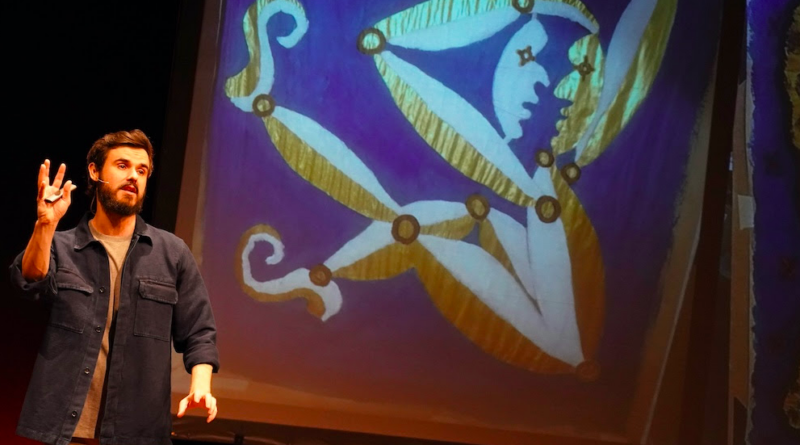INTERVIEW: Documenting mental health through art and theater
Photo: 300 Paintings was created by Sam Kissajukian, who also performs in the solo show. Photo courtesy of Carol Rosegg / Provided by The Press Room with permission.
Sam Kissajukian, a former standup comedian from Sydney, has taken his new solo show on a worldwide tour, engaging audiences with his unique, moving and hilarious exploration of the many facets of mental health. 300 Paintings, playing through Sunday, Dec. 15, at the Vineyard Theatre in New York City, began its life as a show at the Edinburgh Fringe Festival this past summer. That engagement in Scotland was a major step forward for Kissajukian, who hadn’t left Australia in six years.
“It was a bit of a big thing for me, kind of pulling all my resources together,” Kissajukian said about his trip to Europe. “It went great in Edinburgh; it was a big surprise, and then Sarah Stern, who is the artistic director of the Vineyard Theatre, saw the show. And in mid-September, she called me and just asked if I wanted to come over. … They pulled some strings and moved very quickly. Within four weeks, I was over in New York.”
The central conceit of the show is Kissajukian’s attempt to understand the connections between art and mental health. He offers projections of some of the 300 paintings that he created during a difficult time in his life — a five-month manic bipolar episode, according to press notes. What he didn’t know at the time was that these paintings would serve as documentation of his mental states and could provide some insights to others around the world.
“It’s slowly dawning on me how grateful I should be,” he said about his off-Broadway engagement. “My background is not in theater. I was a standup comedian for 10 years, and then over the last couple of years, I’ve been a visual artist. And so when I quit standup three years ago, I didn’t actually think I’d perform again. I’m not from theater, and so it’s a surprise to me that I’ve ended up in theater, and in New York of all places, in this great venue. I mean, it’s embarrassing. They’ve said things before that were just so new to me. I remember the first time they said, ‘Places,’ and I was like, ‘What places?’ I didn’t know.”
Kissajukian admitted that when he was first performing 300 Paintings, there were parts of the narrative that he found difficult to get through with a live audience in the crowd. He thought the piece was too personal and perhaps wouldn’t connect with the lived experiences of the audience members in front of him. It turns out many connections were being made.
“I didn’t think anybody would relate to it,” he said. “It’s the most specific, vulnerable thing I’ve done. I’m so grateful how people responded. So many people either live with mental illness or have friends and family that have gone through it, so they have that empathy and pain and guilt by association. They’ve watched their friends and family go through it. People were very responsive, and it started a lot of interesting conversations for me. I’ve built close friends from it, and so I think the show for me feels like starting a conversation for people to have for themselves, but then also with me. I think that kind of positivity and opening of discussion overrules any of the intensity that it has for me. I mean, the show does take a lot of energy. It’s an 80-minute show, and I kind of relive this thing. I try to be really authentic to how I’m feeling and not feel like a performer on stage, just try to be a human being. I live a pretty low-key life outside of that to kind of recoup so I can do this each day.”
Kissajukian said that what thoughts and narratives people are unable to communicate in conversations can come through in different mediums, like painting or acting.
“And so I think visual art for me is a way that I can express things that I can’t put into words, and so what I found in the purpose of the show is I’m trying to as succinctly and accurately express the inner-workings of my mind and emotions,” Kissajukian said. “And I think by pairing the verbal discourse of the monologue superimposed over the visual elements, both with the exhibition and the projections that I use, I think that combination I can be more specific. I think some people are visual learners. Some people learn verbally, and so having those all together gives people emotional autonomy to access what they might understand.”
He added: “Maybe there’s an element where if you have lived experience of mental illness ongoing throughout your life, then society isn’t really set up structurally for you to thrive, and so you’ve had to creatively problem-solve and navigate in social structures your entire life. And I think when you apply that creative problem-solving muscle that is part of your survival to a new medium, like art or music, you actually have much more of a unique lens and tools available to move very quickly through that.”
By John Soltes / Publisher / John@HollywoodSoapbox.com
300 Paintings, created and performed by Sam Kissajukian, continues through Sunday, Dec. 15, at the Vineyard Theatre in New York City. Click here for more information and tickets.

